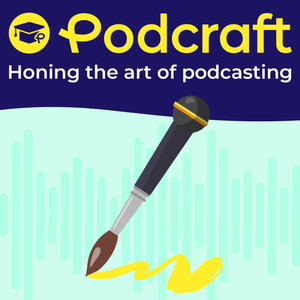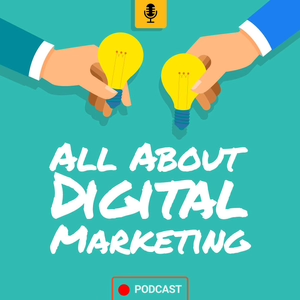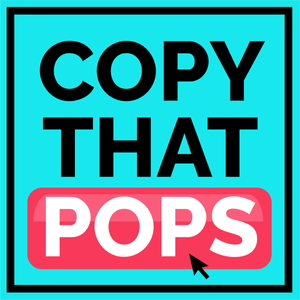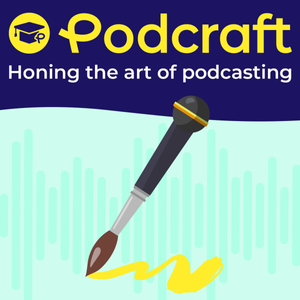
Recording & Editing Software | PodCraft 1107
05/15/19 • 36 min
2 Listeners
In this episode we're looking at Audio production software, commonly know as 'Digital Audio Workstations' in the audio production industry. We'll look at the most common options out there to give you an idea of which one might suit you.
A Digital Audio Workstation (or DAW, for short) is simply an audio editing package that lets you cut out mistakes, splice together different clips and add in music or sound effects. It also allows you to process your audio with a range of different effects, all of which can make your Podcast sound much better. Listen to the episode here to find out more!
Resources Mentioned
- The Podcast Host Academy
- Alitu: The Podcast Maker App
- Audacity
- Hindenburg Journalist
- Adobe Audition
- Reaper
- The Complete Podcast Software Guide
- Best Podcast Editing Software
- Best Podcast Making Apps
- The Minimum Effective Editing Approach
- Best Tools for Recording a Podcast Online
In this episode we're looking at Audio production software, commonly know as 'Digital Audio Workstations' in the audio production industry. We'll look at the most common options out there to give you an idea of which one might suit you.
A Digital Audio Workstation (or DAW, for short) is simply an audio editing package that lets you cut out mistakes, splice together different clips and add in music or sound effects. It also allows you to process your audio with a range of different effects, all of which can make your Podcast sound much better. Listen to the episode here to find out more!
Resources Mentioned
- The Podcast Host Academy
- Alitu: The Podcast Maker App
- Audacity
- Hindenburg Journalist
- Adobe Audition
- Reaper
- The Complete Podcast Software Guide
- Best Podcast Editing Software
- Best Podcast Making Apps
- The Minimum Effective Editing Approach
- Best Tools for Recording a Podcast Online
Previous Episode

Bits & Bobs: Cables, Stands, & More | PodCraft 1106
Cables, stands, jacks, plugs, pop filters – the less glamorous, but still utterly essential part of the podcasting equipment pantheon.
It’s common for podcasters to spend three figure sums on both their mic, and their recording device, then link the two together with a cable they’ll spend $5 on.
On this episode, we look to better understand all these different ‘Bits & Bobs’ by running through what they are, what they look like, and what they do.
Types of Audio Cable & Connection
XLR Cables
XLR cables and inputs. XLR cables are commonly known as microphone cables.
They have a male end and a female end, and are used to connect microphones to equipment, or to create a link between two pieces of equipment (like a mixer to a recorder).
Quarter Inch (1/4”)
The 1/4′′ (6.35mm) plug looks like a bigger version of the 3.5mm plug.
They’re commonly used to connect microphones and other gear to recording equipment such as mixers or preamps.
Most mixers and recorders will allow you to connect either an XLR cable or a 1/4′′ jack to the same port. These are known as ‘Combo Ports’.
The Standard Headphone Jack
The 3.5mm plug/connection is most commonly found on headphones and earbuds. They’re also found on some smaller microphones too, like ‘lavalier' clip on mics, and headsets.
TS, TRS, & TRRS Plugs
Audio plugs (like the 3.5mm plug) have markings on them to determine exactly how they work.
These markings come in the form of little black bands that run around the shaft of each plug.
These bands separate each different function of the plug in question.
A plug with one band is known as a tip sleeve or TS jack. That's because the single band separates the tip from the sleeve.
A plug with two bands is known as a tip ring sleeve, or TRS jack, because the bands have separated a ring in the middle, between the tip and the sleeve.
A plug with two bands is known as a tip ring ring sleeve, or TRRS jack, because that has two rings separated in the middle.
So what's the purpose of all these tips and rings, and how do they work differently?
TS plugs are traditionally known as mono plugs, because the tip is feeding all the audio to the source in one dose.
TRS plugs are traditionally known as stereo plugs because the tip is now being used to feed the left channel of your audio to the source, whilst the ring is feeding the right channel.
In recent years, a third option was added to this setup – the TRRS plug.
The extra ring was brought in to accommodate a microphone or video option. The most common use of TRRS plugs is talking through a headset on your PC, or making a hands free call on your phone.
RCA
RCA connectors are also known as phone cables or AV jacks.
Mixers have RCA ports on them, and these enable you to connect and play media through them.
RCA cables are usually Y shaped, with the white and red stereo audio plugs at one end, and a single plug on the other end, such as a 3.5mm or 1/4′′ connection.
We also cover headphone splitters, microphone stands, and pop filters.
Resources Mentioned
- The Best Boom Arm for Podcasting
- Studio Cable Management for Podcasters
- Finding the Best Audio Cables: The (Not So) Fascinating Truth
- Best Podcast Microphones on the market
- Alitu - Our Podcast Maker App
Work With Us
No matter what kind of studio setup you think you'll need, or whatever kind of podcast you'd like to do, you can get all the help, suppor
Support the showNext Episode

Podcast Gear Stats: What Are Podcasters ACTUALLY Using? RODE Procaster Giveaway
Okay, granted, having a top-of-the-range mic doesn't necessarily mean you'll have top-of-the-range content. But the various bits of equipment different folks are using to create audio can become an obsession for some podcasters.
We know this because the Equipment section of our site is by far the most viewed and visited. Combine that with your average podcaster's love of stats, and that's what led to us running our first podcasting gear stats survey back in 2017/18.
Well, that survey is back, and we want to see what the podcast equipment landscape looks like now, in 2019. Has anything changed in this bold new era where you can launch a media hosting service one morning, and sell it an hour later for $400 million? Take a minute or two to fill out the survey and help us find out.
But it's not just hard data that could be your reward here. We've put together some great prizes which will be drawn and distributed at random amongst six lucky entrants.
Platinum Prize
Rode Procaster (XLR) OR Rode Podcaster (USB) – your choice! (worth ~$250)
Or a $200 podcast equipment equipment budget on Amazon.
Gold Prize
One year's free membership to The Podcast Host Academy.
That's our membership site where you can use our comprehensive catalog of courses and resources to plan, launch, and grow your podcast. In there, you can join in with our active community and take part in our regular live Q&A sessions.
Silver Prize
Six month subscription to Alitu: The Podcast Maker App.
With Alitu you can record your content, build your episode, and publish to your media host without having to learn the ins and outs of audio production.
Bronze Prizes
Three copies of Out on the Wire, by Jessica Abel. This book is a masterclass in audio storytelling, and an essential read for podcasters of all levels.
Survey Closes: 11:59pm Pacific Time, Tuesday 4th June
Take the Survey
If you like this episode you’ll love
Episode Comments
Featured in these lists
Generate a badge
Get a badge for your website that links back to this episode
<a href="https://goodpods.com/podcasts/podcraft-how-to-podcast-and-craft-a-fantastic-show-24207/recording-and-editing-software-podcraft-1107-853518"> <img src="https://storage.googleapis.com/goodpods-images-bucket/badges/generic-badge-1.svg" alt="listen to recording & editing software | podcraft 1107 on goodpods" style="width: 225px" /> </a>
Copy





